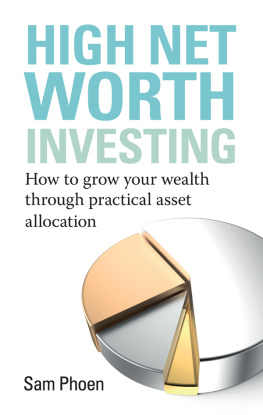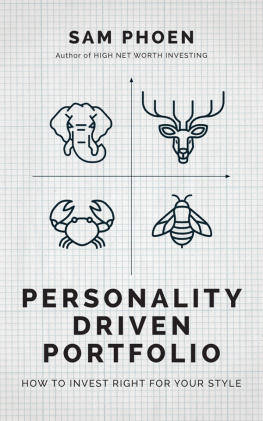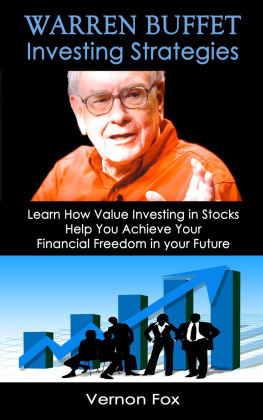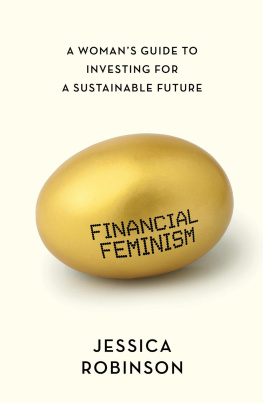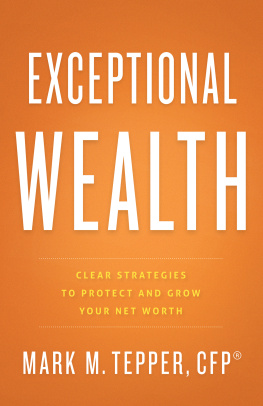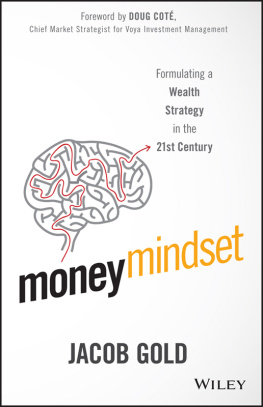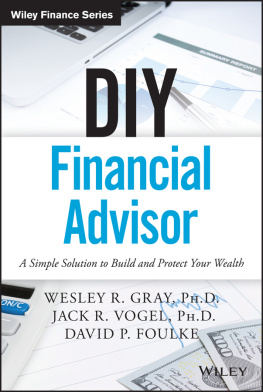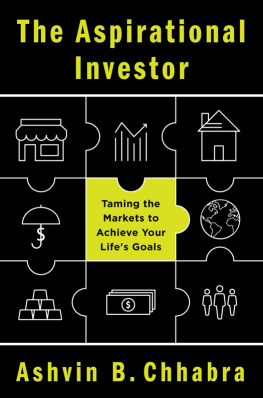HIGH NET WORTH INVESTING
HIGH NET
WORTH
INVESTING
HOW TO GROW YOUR WEALTH
THROUGH PRACTICAL
ASSET ALLOCATION
Sam Phoen

2016 Sam Phoen and Marshall Cavendish International (Asia) Pte Ltd
Published in 2016 by Marshall Cavendish Business
An imprint of Marshall Cavendish International
1 New Industrial Road, Singapore 536196
All rights reserved
No part of this publication may be reproduced, stored in a retrieval system or transmitted, in any form or by any means, electronic, mechanical, photocopying, recording or otherwise, without the prior permission of the copyright owner. Requests for permission should be addressed to the Publisher, Marshall Cavendish International (Asia) Private Limited, 1 New Industrial Road, Singapore 536196. Tel: (65)6213 9300. Email:
The publisher makes no representation or warranties with respect to the contents of this book, and specifically disclaims any implied warranties or merchantability or fitness for any particular purpose, and shall in no event be liable for any loss of profit or any other commercial damage, including but not limited to special, incidental, consequential, or other damages.
Other Marshall Cavendish Offices:
Marshall Cavendish Corporation. 99 White Plains Road, Tarrytown NY 10591 9001, USA Marshall Cavendish International (Thailand) Co Ltd. 253 Asoke, 12th Flr, Sukhumvit 21 Road, Klongtoey Nua, Wattana, Bangkok 10110, Thailand Marshall Cavendish (Malaysia) Sdn Bhd, Times Subang, Lot 46, Subang Hi-Tech Industrial Park, Batu Tiga, 40000 Shah Alam, Selangor Darul Ehsan, Malaysia.
Marshall Cavendish is a trademark of Times Publishing Limited
National Library Board, Singapore Cataloguing-in-Publication Data:
Name(s): Phoen, Sam.
Title: High Net Worth Investing : How to grow your wealth through practical asset allocation / Sam Phoen.
Description: Singapore : Marshall Cavendish Business, 2016.
Identifier(s): OCN 950473893 | eISBN: 978 981 47 5171 1
Subject(s): LCSH: Asset allocation. | Portfolio management. | Finance, Personal. Classification: DDC 332.6dc23
Cover design: Benson Tan
Cover image: AlexLMX/Shutterstock.com
Printed in Singapore by Markono Print Media Pte Ltd
CONTENTS
Preface
I HAVE INVESTED for the firms I worked for and for myself all my life. I have made money, I have lost money. I gained a lot of knowledge and insights in the process especially when I lost money. It hurts, but it made me learn. Some lessons can only be learnt when they hurt us, but there are also lessons which can be learnt without going through the hard way.
Fortunately for me, I have had more joy than pain over the years. From a personal investment perspective, I have invested in equities, bonds, cash products, real estate, foreign exchange, private equity and hedge funds. I have also dabbled in many kinds of structured products linked to these asset classes.
Thanks to these experiences, I have often been approached by friends and colleagues for investment advice. I totally enjoy sharing these experiences, as I find that my thoughts are a lot clearer when I have to articulate my suggestions or recommendations to them. The frequent sharing prompted me to share my experiences with more people, hence the book.
This book is like a compilation of my investment knowledge and experience over the years. Obviously I cant be an expert in each and every topic I write about. I would like to thank my long-time friend Kenneth Yeo for sharing his vast experience and expertise in Private Equity investments, my friendly insurance specialist Joey Seah for vetting the Insurance Summary Table, my nephew Siu Yen Lo for assisting me with other possible cover designs, and my ex-c olleague and co-founder of Call Levels Daniel Chia for helping me with the price charts. Most of all, I am particularly grateful to my family, friends and colleagues who have supported me along the way, and gave me the motivation to write the book.
Its my hope that after reading this book, every High Net Worth and retail investor will be able to navigate safely through mistakes that are avoidable, ask the right questions, and approach any potential investments with a more complete perspective. A perspective that your investment adviser may not sufficiently cover, a perspective that most investors would not normally think of, and a perspective where you know for sure what you are buying.
Sam Phoen
June 2016
Introduction
FINANCIAL PRODUCTS ARE evolving constantly, just as regulations have been evolving to better protect consumers and investors. Post global financial crisis, the investment landscape has improved, and retail investors in particular are much better protected, with many safeguards to ensure they are well-informed and a financial products risk profile is suitable for them.
However, this is only the bare minimum required to protect a retail investor. The usual principle of caveat emptor, Latin for let the buyer beware, is still crucial in any financial transaction, because the seller tends to have more information than the typical buyer. This is understandable as retail buyers are typically not professionals in finance, and thus will only have limited technical knowledge with respect to financial products.
This book does not teach concepts of finance like those taught in Finance 101 in university. It does not cover complex mathematical formulas for calculating the fair value of financial products, as most of us would be lost halfway through. It also does not tell you what to buy or what not to buy.
This book attempts to help retail investors and high net worth individuals (HNWIs) understand in simple terms some of the common retail products available in the marketplace. It breaks down seemingly complex retail products into bite-size bits so investors can understand what they are buying. It helps investors think through whether what they are buying is indeed correctly expressing their own investment views. It also points out many less obvious pitfalls and considerations that are usually not highlighted by sellers of financial products.
Put another way, in the common analogy of teaching someone how to fish versus giving him a fish, this book certainly does not catch the fish for you. In all likelihood, you probably go fishing occasionally and know a little of how to fish already. This book identifies the rivers, lakes and oceans you could be fishing in and the kinds of fish available in each of them, helps you understand which of these fish may be suitable for you, and teaches you how to fish intelligently to achieve your target haulage.
Buying retail products should ideally not be a standalone or occasional decision. It should be deliberate and part of a well-thought-out investment plan. For example, what is the significance of a one-off 50% return on a $5,000 investment in a retail investment product when you have $500,000 that you leave in the current account uninvested? Would you achieve your bigger target with such ad hoc random return?
To formulate a proper investment plan that meets your investment needs, your entire investable assets should be considered in totality. A plan that matches your investment objectives and risk appetite should be drawn up such that a holistic approach to investment may be designed and implemented over time. This involves what financial planners traditionally call asset allocation.
Asset allocation plans for retail investors and HNWIs are usually rather standardised in textbooks. Most financial literature has several cookie-cutter types of investment plans depending on ones age and income. The biggest drawback of these plans is that they usually only work if one has a few million dollars in the bank, but not when one only has a few hundred thousand, or less. These plans do not consider the practical difficulties when one is investing a much smaller capital amount. They also do not explain how two similar people with the same age and income may end up with very different investment strategies as each might have very different needs and risk appetites. This book hopes to demystify some of these big concepts and suggest a practical approach to individuals intending to achieve their dreams through appropriate planning and investing.
Next page
